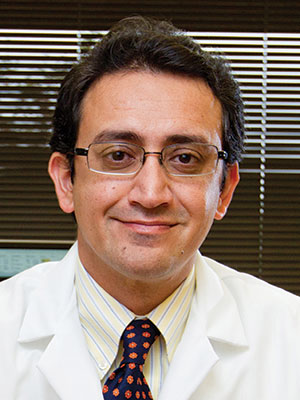
Basic discoveries about scleroderma are starting to open pathways leading to novel treatments, starting with the approval of nintedanib for the treatment of scleroderma associated interstitial lung disease earlier in 2019.
Systemic sclerosis is a complex disease involving immune activation, vascular complications, and tissue fibrosis in the skin, lungs, and elsewhere. Recent work has been done in the genetics and epigenetics of scleroderma and identifying new pathways that offer promising targets. Some of those pathways are similar to pathogenic pathways seen in certain cancers for which targeted therapies are already approved or in clinical development.
“We have a greater understanding of the pathogenesis of scleroderma,” said Dinesh Khanna, MD, MSc, Professor of Medicine and Director of University of Michigan Scleroderma Program. “As we understand more about the interplay of different molecular and epigenetic mechanisms and how they interact with the vascular, immune, and fibrotic pathways in scleroderma, we can either repurpose existing drugs, like we have done with tocilizumab or abatacept, or develop new targets that can be helpful in treating this disease.”
Dr. Khanna will discuss current trial design based on recent trials and emerging therapeutic targets during Genetics and Epigenetics of Scleroderma on Monday from 7:30 – 8:30 am in Room B308, Building B in the Georgia World Congress Center.
Timothy Radstake, MD, PhD, Professor of Rheumatology and Clinical Immunology and Chair of Translational Immunology at UMC Utrecht, The Netherlands, will focus on the basic science behind some of the novel therapies for scleroderma now in development.
Scleroderma remains a relatively rare disease, Dr. Khanna noted, with about 150,000 patients in the United States. Most rheumatologists are familiar with the condition, but few treat more than an occasional patient with scleroderma on a regular basis.
One of the more promising new epigenetic targets is EZH2, which is known to play a role in several types of cancer, idiopathic pulmonary fibrosis, and chronic kidney disease. This epigenetic protein regulates gene expression through DNA methylation to drive fibrosis and the abnormal angiogenesis seen in scleroderma. The marker has been identified in lupus as well as in scleroderma.
EZH2 is a histone methyltransferase enhancer that is overexpressed in fibroblasts and endothelial cells in scleroderma, Dr. Khanna said. Inhibiting EZH2 effectively reduced the expression of profibrotic genes in fibroblasts in both animal models of scleroderma and in patients with scleroderma. In endothelial cells, inhibiting EZH2 restored normal angiogenesis.
“The beauty of this is that there are drugs that are available, either in clinical trials in various cancers or in development by different pharmaceutical companies, that could be considered in early phase 1 clinical trials in scleroderma,” Dr. Khanna said. “This is true not just for EZH2 but for many epigenetic modulators, published by our group and by others.”
None of these findings change the way scleroderma is treated today, he cautioned, but much of the basic science in scleroderma is ready for translational research or is already in clinical trials in other diseases, most often cancer.
“The developments in genetic and epigenetic work that has been going on in scleroderma raise the realistic opportunity that these epigenetic mechanisms may be a target for clinical trials in the very near future,” he said. “Our improving understanding of the mechanisms involved will help us better understand the pathogenesis of scleroderma and guide us to finding effective therapies for the disease,”
